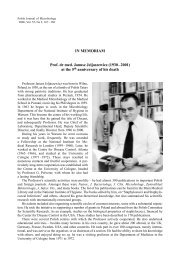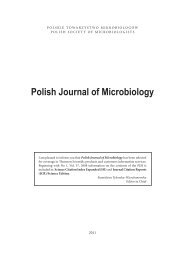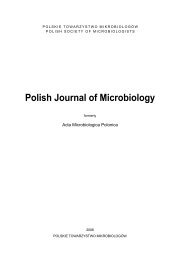Production and Characterization of Esterase in Lantinus tigrinus for ...
Production and Characterization of Esterase in Lantinus tigrinus for ...
Production and Characterization of Esterase in Lantinus tigrinus for ...
You also want an ePaper? Increase the reach of your titles
YUMPU automatically turns print PDFs into web optimized ePapers that Google loves.
102<br />
Tahir L. et al. 1<br />
showed clear zone <strong>of</strong> hydrolysis on plates. Furthermore,<br />
production <strong>of</strong> esterase was carried out <strong>in</strong> PYD broth<br />
medium conta<strong>in</strong><strong>in</strong>g 5 g/L peptone; 3 g/L beef extract;<br />
5 g/L sodium chloride; 5 g/L yeast extract, <strong>and</strong> 1 g/L<br />
Dextrose. The PYD media was <strong>in</strong>oculated with 10%<br />
fungal homogenate <strong>and</strong> fermented at 37°C, 150 rpm<br />
<strong>in</strong> shaker <strong>in</strong>cubator <strong>for</strong> 96 hr. Samples were collected<br />
after every 24 hr <strong>and</strong> esterase activity was per<strong>for</strong>med<br />
<strong>in</strong> cell free extract. To access esterase activity, crude<br />
enzyme was treated with 1 M ρ-nitrophenyl acetate,<br />
follow<strong>in</strong>g the procedure described by Maeda et al.<br />
(2005). The optical density was measured <strong>in</strong> spectrophotometer<br />
at 380 nm. St<strong>and</strong>ard curve was drawn by<br />
react<strong>in</strong>g crude enzyme with vary<strong>in</strong>g concentration <strong>of</strong><br />
ρ-nitophenyl (0.01–0.1 mg/ml). One unit <strong>of</strong> esterase<br />
activity is def<strong>in</strong>ed as the amount <strong>of</strong> enzyme which<br />
releases 10 µg <strong>of</strong> p-nitrophenol/ml under the st<strong>and</strong>ard<br />
assay conditions.<br />
For the morphological identification, Lant<strong>in</strong>us tigr<strong>in</strong>us<br />
was grown on malt extract media (Merck). After<br />
seven days <strong>of</strong> culture at 37°C, morphological characters<br />
were observed. For molecular identification, total<br />
genomic DNA was extracted accord<strong>in</strong>g to the method<br />
<strong>of</strong> Anderson et al. (1996) follow<strong>in</strong>g amplification <strong>of</strong> ITS<br />
regions by PCR. Universal primers ITS-1 5’-TCCG-<br />
TAGGTGAACCTGCGG-3’ <strong>and</strong> ITS-4 5’-TCCTC-<br />
CGCTTATTGATATGC-3’ were used as previously<br />
described by Webb et al. (2000). Amplified products<br />
were purified <strong>and</strong> sequenced us<strong>in</strong>g the ABI BigDye<br />
Dideoxy Term<strong>in</strong>ator Cycle sequenc<strong>in</strong>g kit (Applied Biosystems<br />
Inc., Warr<strong>in</strong>gton, United K<strong>in</strong>gdom) follow<strong>in</strong>g<br />
<strong>for</strong>ward <strong>and</strong> reverse sequences alignment us<strong>in</strong>g ABI<br />
Auto-assembler s<strong>of</strong>tware (Applied Biosystems Inc.).<br />
The overlapp<strong>in</strong>g consensus sequence was compared<br />
with sequences <strong>in</strong> the NCBI database us<strong>in</strong>g FASTA 3<br />
sequence homology searches.<br />
For production <strong>of</strong> maximum esterase, PYD medium<br />
was used as described be<strong>for</strong>e <strong>in</strong> all experiments otherwise<br />
mentioned. For pH optimization, the pH <strong>of</strong> the<br />
media was adjusted to 3, 4, 5, 6, 7, 8, 9 <strong>and</strong> 10. For<br />
temperature condition st<strong>and</strong>ardization, <strong>in</strong>oculated<br />
media (pH 5) flasks were kept on orbital shaker at 30°C,<br />
37°C <strong>and</strong> 45°C at 150 rpm. Three different substrates as<br />
<strong>in</strong>ducer (Tween 20, Tween 80, <strong>and</strong> olive oil) at 1% each<br />
were also exam<strong>in</strong>ed <strong>for</strong> enzyme production. Interaction<br />
<strong>of</strong> application <strong>of</strong> <strong>in</strong>ducer with rage <strong>of</strong> temperature<br />
(30°C, 37°C <strong>and</strong> 45°C) was also studies. For optimization<br />
<strong>of</strong> nitrogen source, M<strong>in</strong>eral medium (0.25 g/L<br />
Citric acid; 0.02 g/L CaCl 2<br />
; 5 g/L K 2<br />
HPO 4<br />
; 0.50 g/L<br />
MgSO 4 . 7H 2<br />
O) with different nitrogen sources was<br />
used. All the experiments were per<strong>for</strong>med <strong>in</strong> triplicate<br />
<strong>and</strong> samples were collected at 24 hr <strong>in</strong>tervals. Enzyme<br />
assay was per<strong>for</strong>med as mentioned be<strong>for</strong>e. Total prote<strong>in</strong><br />
was also analyzed <strong>in</strong> all samples follow<strong>in</strong>g the method<br />
described by Lowry et al. (1951).<br />
For partial purification <strong>of</strong> esterase, the culture filtrate<br />
was concentrated by 70% (NH 4<br />
) 2<br />
SO 4<br />
<strong>in</strong> 50 mM Tris<br />
HCL buffer (pH 8). Concentrated esterase was dialyzed<br />
by ultra-filtration (dialyzed by us<strong>in</strong>g 12000 M.W cut<br />
<strong>of</strong>f dialyz<strong>in</strong>g bag) <strong>and</strong> chromatographed us<strong>in</strong>g Sephadex<br />
G-75, eluted with 50 mM tris HCl buffer, pH 8.<br />
A volume <strong>of</strong> 3 ml fraction was collected <strong>and</strong> assayed<br />
<strong>for</strong> enzyme activity <strong>and</strong> amount <strong>of</strong> prote<strong>in</strong>. The procedure<br />
<strong>for</strong> enzyme assay as def<strong>in</strong>ed be<strong>for</strong>e was followed<br />
<strong>for</strong> the degradation <strong>of</strong> plastics except that <strong>in</strong>stead <strong>of</strong><br />
ρ-nitophenyl acetate 0.1% polystyrene film was <strong>in</strong>cubated<br />
at 37°C. After 72 hr <strong>of</strong> <strong>in</strong>cubation, the films were<br />
removed <strong>and</strong> thoroughly washed with distilled water.<br />
Degradation <strong>of</strong> the film surface was <strong>in</strong>itially exam<strong>in</strong>ed<br />
microscopically follow<strong>in</strong>g FTIR spectroscopic<br />
analysis <strong>in</strong> an Analect RFX-75 spectrometer through<br />
st<strong>and</strong>ard protocol.<br />
Growth <strong>of</strong> Lent<strong>in</strong>us tigr<strong>in</strong>us <strong>in</strong> m<strong>in</strong>eral salt medium<br />
produced hydrolytic enzyme. The clear region <strong>in</strong> agar<br />
conta<strong>in</strong><strong>in</strong>g petri plates confirmed release <strong>of</strong> enzyme <strong>in</strong><br />
the medium under normal conditions. Colonies <strong>of</strong> the<br />
stra<strong>in</strong> were light colored, smooth <strong>and</strong> flat on the surface<br />
with sporous appearance. The isolate was identified by<br />
5.8S, 18S, 28S rRNA <strong>in</strong>ternal transcribed spacer (ITS)<br />
region sequenc<strong>in</strong>g. Sequences were compared with<br />
known sequences <strong>and</strong> deposited to NCBI with accession<br />
number EU543989. Increase <strong>in</strong> pH from acidic<br />
to basic decreased production <strong>and</strong> specific activity <strong>of</strong><br />
esterase (Fig. 1). Maximum esterase production <strong>and</strong><br />
specific activity was observed on 4 th day when cultured<br />
at acidic medium. However; at pH 7 <strong>and</strong> 8, maximum<br />
activity was observed on 5 th day <strong>of</strong> culture. Lant<strong>in</strong>us<br />
tigr<strong>in</strong>us also prefered neutral to acidic condition <strong>for</strong><br />
production <strong>of</strong> esterase like other esterase produc<strong>in</strong>g<br />
microbes (Buzz<strong>in</strong>i <strong>and</strong> Mart<strong>in</strong>i, 2002; Kudanga et al.,<br />
2007). At 30°C, esterase production gradually <strong>in</strong>creased<br />
up to 5 th day <strong>of</strong> culture (Fig. 2). However, 37°C was<br />
found optimum <strong>for</strong> production <strong>of</strong> esterase. At this<br />
temperature maximum esterase production (10 U/ml)<br />
<strong>and</strong> maximum specific activity (0.4 μg/ml prote<strong>in</strong>) was<br />
atta<strong>in</strong>ed on 5 th day <strong>of</strong> culture. At all the temperatures,<br />
production <strong>and</strong> specific activity drastically decreased<br />
when culture was <strong>in</strong>cubated <strong>for</strong> more then five days.<br />
Maximum esterase production from Aureobasidium<br />
pullulans has been reported at 35°C <strong>and</strong> its production<br />
decreased with <strong>in</strong>crease <strong>of</strong> cultur<strong>in</strong>g temperature<br />
(Kudanga et al., 2007).<br />
Tween 80 had a positive role <strong>in</strong> production <strong>of</strong> esterase<br />
(Fig. 3). In all the cases esterase production <strong>and</strong><br />
specific activity was maximum at 37°C as compared<br />
with 30 <strong>and</strong> 45°C. Tween 20 was also found better<br />
<strong>for</strong> production <strong>of</strong> esterase at 30 <strong>and</strong> 37°C. However,<br />
<strong>in</strong> the presence <strong>of</strong> tween 80 specific esterase activity<br />
was higher. The results also describe that Lant<strong>in</strong>us<br />
tigr<strong>in</strong>us does not prefer the presence <strong>of</strong> fatty acids






